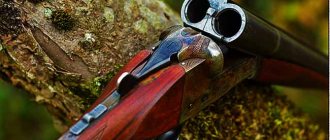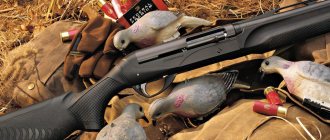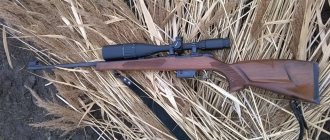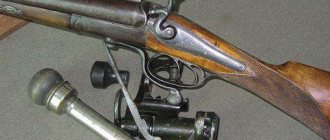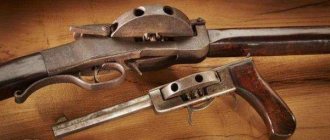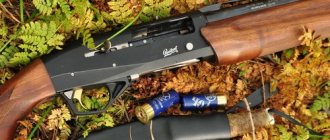What does 20 gauge mean?
First, let's figure out what the number 20 in the name of the caliber means. Some novice hunters, who know that millimeters are used to indicate the caliber of rifled weapons in Russia, have difficulty navigating among 12, 20, 28 and 32 calibers. Many people are surprised how a 20 gauge or 32 gauge barrel can be smaller than a 12 or 16 gauge barrel.
In fact, everything is simple here - this calibration system is tied to the English pound, which is 454 grams. Caliber indicates how many bullets for a particular gun can be cast from a pound of lead. For example, if only 12 bullets can be cast for one large-caliber gun, then the caliber will be 12. But if you take a smaller caliber, then one pound is enough for as many as 28 bullets. Accordingly, the conversation is about a 28-caliber smoothbore shotgun.
Therefore, if we talk about a 20-caliber gun, then 454 grams of lead is enough for 20 charges.
How to choose a 20-gauge shotgun?
If, after studying the pros and cons of the 20-gauge, you decide to purchase such a gun, it is important to choose the right specific version - it could be 20x70, 20x73 or magnum - 20x76. The first two options are preferable, but guns designed for use with 20×76 cartridges have practically no advantages over 12-gauge models, while the disadvantages are obvious - consumables for them are more difficult to purchase, the shot sheaf of such weapons is narrower
Still, less weight and length are the main advantages of twenty, but in the magnum version they weigh too much. If possible, it is worth purchasing a gun from one of the foreign manufacturers, since in this case there is a large selection of light and compact models.
For example, 20-caliber shotguns in Russia today are produced IZH-27 and IZH-43. Their significant drawback is their heavy weight: the weight of the IZH-27 is 3.1 kg, and the magnum version weighs 3.3 kg. For IZH-43 this is 3.1 and 3.4 kg, respectively. Thus, there is practically no point in buying these models: they weigh the same as a 12-gauge shotgun, while a good twenty should be light so that it is easy to move with it around the hunting grounds and raise it in preparation for a shot.If you need to walk 10-15 kilometers per day, its benefits will be obvious.
People who buy such weapons usually have a good understanding of their advantages and disadvantages, and therefore know how to hunt with them. With a light, sleek and compact double-barreled shotgun, you can take many trophies and have a great hunting experience.
What guns are produced in Russia for this caliber?
If you are seriously interested in 20 gauge, then Russian manufacturers are able to offer a fairly rich assortment. We will not touch on foreign analogues - otherwise we will have to write a whole book.
For example, lovers of semi-automatic weapons will be pleased with the MP 20 caliber shotgun - MP-155. The long barrel allows you to hit a target at a really long distance. True, it is not very convenient to make your way through thickets of reeds or bushes, as well as under low-hanging branches.
Fans of TOZ 20 gauge will not be disappointed either. Manufacturers pleased fans with a very successful gun - TOZ-134-20. This is practically a clone of the truly legendary “vertical”, which has received the love and recognition of hundreds of thousands of hunters in our country - TOZ-34. However, unlike the latter, the gun is designed for 20 gauge cartridges. And not 12 at all, alas.
The most numerous is the IZh family - 20 gauge allowed the developers to go all out. This can easily include IZH-18, IZH-27, IZH-58 and some others. By the way, it is the IZH-27 that can be confidently called the most popular gun in the territory of the former USSR. They started producing it back in 1973 and are still producing it to this day. During this time, over one and a half million guns were created. And that means something. Hunters are practical people and are unlikely to buy low-quality weapons.
Finally, fans of the military style will certainly be pleased with the 20-gauge Saiga. It is available in four versions:
- "Saiga 20" is a classic gun, developed on the basis of the Kalashnikov assault rifle.
- “Saiga 20C” - the main difference from the classic version is the ability to fold the butt.
- Saiga 20K is a shortened version that also has a folding stock. However, unlike the previous gun, this model is equipped with a safety mechanism that does not allow firing with the stock folded.
- “Saiga 20C – Exp-01” is a model intended for export to countries with more lenient weapons legislation. In general, it is similar to Saiga 20K, but unlike it, it does not have a protective mechanism. This makes it possible to shoot without unfolding the butt.
As you can see, the choice is really rich. Surely, among such diversity, even the most picky hunter will easily choose a 20-gauge shotgun that will definitely suit his taste.
20 gauge. Personal experience
This caliber always excites the minds of hunters, especially when it is possible to use magnum cartridges. It's tempting to get a gun with a completely different feel, but with the capabilities of a 12 gauge. Is it really? Reading A.P. Ivashentsov’s book “Combat and the Service of a Shotgun,” it seems that this is so. The author of the book really answers many questions related to the combat of small-caliber smoothbore guns. Many of the examples given in the book are still relevant today. For any hunter who wants to have a 20-caliber gun, A.P. Ivashentsov’s work will provide comprehensive answers to many questions.
My personal experience of using 20-gauge hunting began with the MTs 20-01 shotgun and was clearly unsuccessful. Most likely, the problem was not in the gun, it’s just that in the 90s of the last century they did not produce normal 20-caliber cartridges, so the gun was not used on the hunts for which it was intended. Then there was a long break, during which I had the opportunity to shoot from various 12-gauge shotguns. So, I probably would have shot only from this caliber, if not for chance.
My friend decided to buy himself a 20-gauge shotgun for hunting with a gun dog. The choice fell on the Beretta Silver Pigeon 687 series, weighing 2.8 kg. The gun had barrels 760 mm long with fixed chokes of 0.2 and 0.6 mm. The length of the trunks seemed too long, but later hunting practice showed that it was just right. Test shooting at targets with Clever Mirage cartridges with shot shell No. 5, weighing 28 g at a distance of 35 meters, was not impressive, especially the picture of shot scree from the lower barrel. And this despite the fact that the muzzle narrowing of 0.2 mm in the 20 gauge is not the same narrowing in the 12 gauge. The upper barrel with a 0.6 mm choke showed that it is better not to shoot with this cartridge beyond 35 meters. We agreed that we couldn’t expect more from a 20-gauge. Of course, when shooting with shot No. 7, all targets would look more presentable. The feeling from the gun itself was very favorable; I didn’t want to let it go. A serial 12-gauge shotgun weighing 3.2 kg seemed like a shaft after 20 shots. But that was where the admiration ended for now.
Shooting on the skeet and compact sporting ranges showed that the gun was underestimated. Targets with different trajectories fought properly. We decided to try shooting with large shot. The 20-gauge cartridge No. 0 Clever Mirage magnum 360 with a shot weight of 36 g pleased me. Unexpectedly, we recorded quite comfortable recoil (with such and such a mass of shot!) and very decent scree at a distance of 40 meters. Test firing of 20-gauge Clever Mirage magnum 360 cartridges on a ballistic barrel, to be honest, surprised me. The initial speed (V0) corresponded to the declared value of 370 m/s, but the pressure was no more than 700 bar. This cartridge was used to confidently shoot geese at distances of up to 40–45 meters inclusive.
The spring hunt finally dispelled all our doubts about the combat and capabilities of a 20-gauge shotgun. All the spring game was killed, there were practically no wounded animals. Subsequently, the gun was systematically fired with Clever Mirage cartridges with a shot mass of 28 g for three years, although not without consequences. The trigger gun had to be repaired twice. Otherwise everything was fine. These trigger repairs led me to the idea that with constant interaction with cartridges where the shot mass is 28 g or more, a light serial 20-caliber double-barreled shotgun is most likely “not a fighter.” A.P. Ivashentsov also warned about this in his book; he called such guns with the words “zephyr” and “feather”. And the 20-gauge gun, weighing 3.2 kg, was not impressive, since it lost its main advantage over the 12-gauge - lightness, although it was much better adapted to the above-mentioned cartridges.
All that remained was to pay attention to semi-automatic devices. After a short analysis, I decided to purchase a 20-gauge Companion semi-automatic from Ata Arms. An inexpensive, lightweight (2.7 kg) gun, without unnecessary innovations. The only surprise was that the 20-gauge gun did not include a “heavy load” gas piston, which allows it to fire magnum cartridges. The manufacturing company assured in the passport that when using a “light load” piston, it is possible to use cartridges with a shot weight of up to 36 g. Shooting with “Fetter-Magnum” cartridges with a shot weight of 32 g showed that a “heavy load” piston would clearly not hurt, since the cartridges flew out of the box at a distance of up to 5 meters. This means that the recoil speed of the shutter is clearly high, although the pressure developed by the magnum cartridges was quite adequate. The automation worked, but the question arose about how long the gun could function in this mode. Of course, if you shoot shot loads up to 28 g, the “light load” piston provides a gentle regime for the mechanisms, but such cartridges did not allow the full capabilities of the gun to be realized.
Remembering that the Companion model is an almost exact copy of the Italian semi-automatic Marocchi A20, I purchased a “heavy load” gas piston from an Italian gun. The automation began to function as expected; magnum cartridge casings did not fly further than 2.5–3 meters. In a word, everything returned to normal. The gun provides comfortable recoil when firing all cartridges, including magnum. Thanks to its low weight and comfortable recoil, “triplets” began to be obtained for the first time when shooting at game birds. This was not possible with the 12 gauge. I loaded cartridges with different weights of shot and different brands of gunpowder. Problems arose with the fact that officially only 20-gauge cartridges are on sale and there is no UPS for this caliber. Therefore, it is better to assemble cartridges on special imported portable machines (Hornady 366 Auto; RCBS; Ponsness Warren 375C; LEE; MEC). Domestic gunpowder “Sunar 42/2” and “Falcon”, when loaded with cartridges with a shot weight of 30–32 g into a 70 mm cartridge case, ensured normal combat. But unlike the Vetter-Magnum cartridges, at V0 = 395–400 m/s, the pressure in the chamber was 110–140 bar higher.
Experimental shooting of cartridges with Sunar 410 powder on a ballistic gun barrel showed that when weighing 30–32 g of shot, it is not worth taking a weigh of gunpowder more than 2.0–2.1 g. Cartridges with a shot weight of 32 g or more are necessary when hunting migrating ducks and shooting hares and foxes in winter; fortunately, the 760 mm long gun barrel made it possible to successfully realize their capabilities. “Fetter-magnum” with No. 5 shot in combination with a 0.75 mm muzzle constriction made it possible to successfully shoot late-autumn mallards at a distance of 35–40 meters. The fox and hare confidently shot with this cartridge with shot No. 1 at a distance of up to 40 meters.
The “Glavpatron-semi-magnum” with shot No. 3 showed very good results when hunting a white hare by tracking. An attempt to shoot a self-rolling large shot with a projectile weight of 30–32 g and sprinkling the shot with starch at a distance of 50–55 meters or more showed that it is better to abandon this idea. Probably, when shooting at a stationary target, hits at such distances are possible, but there is little chance of hitting a moving target. In any case, it turned out to be unlikely to get a picture of a shot shell similar to the 12-gauge, although the mass of the shot shell was the same - 32 g. Neither starch nor changing the choke helped. The range of confident destruction with a good magnum cartridge from a 20-gauge shotgun is no more than 45 meters, the rest is a matter of chance and luck. There is nothing wrong with this since this is the range at which 90% of all shotgun shots are fired.
If you try to get a 20-gauge shotgun as a universal tool for hunting, then the requirements for it will be higher than for a 12-gauge shotgun. Combining low weight and structural strength is very difficult, especially if you plan to shoot magnum cartridges frequently. Shooting them from a 20-gauge shotgun feels deceptive. Recoil, as a rule, is quite comfortable, and the pressure in the chamber is serious (950–1000 bar), especially when using domestic powders. Magnum cartridges and the possibility of their trouble-free use in a 20-gauge shotgun received a lot of attention due to the desire to obtain a universal shotgun with a low mass. Probably, in some models of semi-automatic machines with a gas outlet or inertial automation circuit, this is possible. Considering that the predicted distance for shooting shotguns from a 20-gauge shotgun is 40 meters, we can say that the magnum cartridges presented on the Russian market (Clever Mirage; Vetter; RC; Barnagi; Rottweil) cope with their task quite well successfully. The 1.00 mm choke, which in the 20-gauge provides shot parameters similar to those of the 1.2-mm choke in the 12-gauge, was used quite effectively when shooting with shot No. 7–6 on early autumn wood pigeon and duck hunts. The opinion that it is difficult to shoot a 20-gauge shotgun with standard shot loads (24–26 g) from a full choke has not been confirmed. The main thing is to shoot with small shot.
Shooting partridges in late autumn with a Fetter Magnum cartridge with shot No. 5 (32 g) in combination with a 0.75 mm choke turned out to be very effective: in the distance range of 25–40 meters the game was shot cleanly, and sometimes it was possible to make “triplet” shots. At closer distances (15–20 m), when shooting at evening duck flights in October, the Fetter-dispersant cartridge with No. 7 shot worked well. In general, this is the only specialized 20-gauge cartridge for short-range shooting; I have never seen others on the market. It’s a pity, sometimes hunting conditions change quickly, and it’s easier to change the cartridge than the choke. The conclusions were confirmed
A.P. Ivashentsov that the impact of small-caliber rifles depends more on the degree of muzzle constriction than on the concentrator (container) for the shot.
There is a lot of talk among hunters about the extraordinary sharpness of 20-gauge shotguns. My subjective feelings cannot fully confirm this. There were wounded animals, but there was no need to run after them. A 20-gauge shotgun, unlike a 12-gauge shotgun, has a more compact shot sheaf, and the pellets have a smaller velocity spread. As a result, the hunter subjectively feels that the game is fighting cleaner. Due to the greater compactness of the shotsheaf, the twenty is less forgiving to the hunter for errors in lead than a 12-gauge shotgun.
Perhaps many may ask whether it would be easier to buy something like a Beretta Ultra Light, Benelli Beccaccia or Franchi Fast Pro 12-gauge shotgun and not bother with the 20-gauge. Of course you can. True, everyone who held a 20-gauge shotgun in their hands noted the difference in the sensations of this weapon compared to a 12-gauge shotgun, even with the same mass. There is no need to talk about recoil; it is less in the 20-gauge with the same mass of shot in the cartridge. 20 gauge magnum cartridges are more expensive. But there is no desire to pick up a 12-gauge shotgun unless absolutely necessary, especially if there is serious hunting ahead. It’s not for nothing, apparently, that so many copies have been broken on the topic of 20-caliber weapons. If it's a good weapon, it's worth it.
Dmitry Vladimirov, Photo by the author
Key Benefits
Now we’ll tell you why this caliber is very popular in our country, second only to 12 and, possibly, 16.
First of all, it is lightness. If you do not take into account models designed for reinforced cartridges, it turns out that 20-gauge hunting rifles weigh significantly less than analogues of larger calibers. For example, a “Saiga” without a magazine weighs 3200 grams, IZH-27 and MR-155 weigh 3100 each, and TOZ-134 is downright fluffy – 2.4 kilograms.
The cartridges also weigh significantly less. And shooters who prefer to load them themselves will also like the fact that the load of shot and gunpowder will be more modest, which means that each shot costs a little less.
Some may think that a gain of 500-700 grams is completely unimportant. But if you've had to walk through the woods all day with a full bandolier on your belt and a gun on your shoulder, which seems more and more heavy with every kilometer you walk, then the benefit is obvious.
An important advantage is the cost of cartridges. They are at least a little, but still cheaper than an analogue of a larger caliber.
With a low weight, 20 gauge can boast of high power. Such guns are often used when hunting wild boar, hare, roe deer, not to mention smaller prey such as goose, duck and quail.
Experienced hunters appreciate it for its relatively low returns. Perhaps after the first shot the difference between 12 and 20 gauges is not too noticeable. But if you fire 10 shots in a row (and for a successful hunt, if you are hunting, for example, a migratory bird) you have to fire much more, then the sensations in your buzzing shoulder will say everything better than words.
Therefore, it is no coincidence that experienced hunters, although with a stretch, still classify 20-gauge shotguns as powerful. Weapons of 24 caliber (which are no longer produced in our country) and smaller ones are considered to be small, suitable exclusively for small prey.
Three-barrel guns (tees)
Currently, tees have become widespread only in German-speaking countries, where they are quite popular.
The main advantage of any tee is its versatility, however, this quality is also fraught with certain disadvantages. The heyday of traditional tees was at the beginning of the 20th century. These models are also called shot tees. They were equipped with two side smooth barrels, as well as one rifled one, located under the first two or between them.
The popularity of trebles is due to the fact that they are suitable for year-round hunting, and with their help you can catch game of almost any size. Tees equipped with mechanical or collimator sights, as well as with a low-magnification optical sight, are often used for driven hunting.
Main disadvantages
Of course, listing all the advantages that 20 gauge has, one cannot fail to mention the disadvantages - nothing can do without them.
First of all, this is a smaller amount of shot or buckshot and, accordingly, a smaller affected area. This reduces the chances of a successful shot, especially if the shooting is carried out at a long distance. However, we will return to this issue a little later.
Range is a controversial factor. Some shooters argue that the smaller powder load leads to the fact that the reliable combat distance of the 12 gauge is much greater than that available for the 20. Others believe that the reduced barrel diameter completely compensates for the small powder load, resulting in the same pressure being created.
But what is undoubtedly a minus is the fact that 20-gauge cartridges are much more difficult to find on sale than 12 and 16. For some reason, despite serious demand, many medium and small stores where 12-gauge cartridges are presented in a huge assortment, they either don’t buy anything less than the popular 20 at all, or they do it very carefully, purchasing little by little.
However, if you don’t trust purchased cartridges too much, preferring to load them the old fashioned way, on your own, the last factor is unlikely to scare you. It is enough to once buy high-quality (preferably brass, if you do not use a semi-automatic shotgun) 20-caliber cartridge cases - they will last for many years even with very active shooting. Well, purchasing gunpowder, a primer and suitable ammunition will not be difficult - they are sold in any hunting store. The only thing that will cause problems in this case is the wads and containers - they must exactly match the specific caliber. However, you can easily make the first ones yourself, having once spent a relatively small amount on a pyzherub. Well, not all hunters who load cartridges themselves use containers. Yes, refusing them reduces the distance of a confident fight. But it reduces the cost of each cartridge by 2-3 rubles, while at the same time providing greater spread of shot or buckshot, increasing the likelihood of hitting prey.
What kind of mining is this caliber suitable for?
In general, it is difficult to list all the prey for which these guns are suitable - that’s why the 20 gauge receives mostly positive reviews from hunters.
Of course, you shouldn’t take it when going after a really large and dangerous animal. For example, a bullet fired from such a gun will seriously injure a bear or an elk and make it very angry - the hunter will have little chance of surviving such an encounter. It can only be taken on a wild boar as a last resort. But otherwise there are no restrictions. Roe deer, hare, moose whale, duck, black grouse, goose, squirrel, quail, woodcock - all of them can become worthy trophies for a good hunter.
This caliber is highly valued by fur-bearing hunters. Still, using a smaller caliber is not a very good idea, since 28 does not provide sufficient combat range. A larger one will simply turn the skin of an unfortunate squirrel or sable into a real colander - using it later will be quite problematic. But not everyone has the opportunity to use rifled weapons, which leave only two tiny holes. Thus, TOZ or “Saiga” 20 caliber will become a really good choice for fur hunters – domestic trappers.
What to choose – classic or Magnum?
But this is a very serious question that neither experienced hunters nor the best gun experts can answer. Indeed, what is better: 20-caliber cartridges with a length of 70 or 76 millimeters? The former are cheaper and provide less return. But the latter allow you to hit prey at a greater distance.
But there is one more factor here that not everyone takes into account, but it is one of the most important! The conversation is about the weight of the gun.
To ensure that the barrel can withstand thousands of reinforced shots without harm, developers are creating guns designed for Magnum shooting - with thicker barrels. Indeed, a necessary precaution, because an ordinary gun can simply burst. But this increases the weight of the weapon! For example, TOZ-134-20, designed for a regular cartridge, weighs 2400 grams, and for Magnum - 2600. For IZH-27, the difference is as much as 500 grams - the version for reinforced cartridges weighs 3600 grams.
Therefore, the answer becomes obvious. If the lightness of the equipment is important to you, allowing you to walk kilometer after kilometer without unnecessary fatigue, then it is better to give preference to a lightweight gun designed to fire 70 mm long cartridges. Well, if you want to feel real power, then perhaps it makes sense to abandon the 20 gauge altogether in favor of a larger one. After all, the weight of a twelve-gauge shotgun and a twenty-gauge shotgun (for Magnum) is approximately the same. And the recoil is quite comparable, but many hunters buy such guns for their teenage sons so that they can gain a useful skill from childhood. For them, the “kick” from a Magnum shot will clearly be too strong, capable of causing injury and discouraging their love of hunting. In addition, by purchasing a 12-gauge gun, you will get rid of the disadvantages that are inherent in small calibers.
Combination shotgun: features
- Each of the barrels has its own ballistic features that are different from the other. Therefore, different aiming devices are installed on them. For rifled barrels there are optical and ring sights (as an option - a rear sight), while for smooth barrels sighting front sights and slats are used.
- It will not be possible to shoot from 2 or more barrels, and the sight will be focused on the barrel that is best targeted. Although many options allow the combination of smoothbore and rifled aiming points.
- Despite their undoubted advantages, such guns have a number of serious disadvantages: they do not have a magazine, and they are very heavy. During ambush hunting, of course, this is not very noticeable, but when walking, the extra pounds put a fair amount of pressure on your back.
Choosing the right ammunition
When going to load cartridges for a new gun for the first time or simply buying them in a store, some hunters will ask themselves: What is better: shot, buckshot or bullet?”
In general, the rules here are the same as when handling other calibers. Well, with the exception that 20-caliber bullets are primarily suitable for not the biggest prey - you can still kill a wild boar with them, but hardly an elk. But a deer hit by such a bullet will definitely not go far.
If you share the point of view that 20 gauge is much weaker than 12, and you are afraid that the charge will not penetrate the plumage of a large bird, such as a goose or wood grouse, then you can always take a shot 1-2 sizes larger. This completely compensates for the lower power, allowing you to return home with some truly impressive trophies.
Types of combined hunting weapons
- "Doubles". As the name implies, one barrel of the gun is rifled, the second is smooth-bore. Such guns are also called choke guns.
- Three-barreled shotguns (“tees”). By analogy with “doubles”, three-barreled shotguns are produced in a combination of 2 rifled barrels + 1 smoothbore or 2 smoothbore + 1 rifled.
- Four-barreled shotgun. A rather exotic category of guns, in which there are 2 barrels of different types (rifled and smoothbore). Basically, they are not used by Russian hunters.
https://youtube.com/watch?v=Jqn6FaVI8VM
The most common combination guns in Russian gun stores are “doubles”.
Need to grow up?
Some experienced hunters, listening to criticism of 20-gauge guns, sigh wearily and from the height of their experience say: “You need to grow up to such a gun!”
Is it really harder to hunt with them than with their 12 and 16 gauge counterparts? As practice shows, yes. This is due to the lower charge.
For example, if you are going for a duck and loading cartridges with shot No. 4, then about 168 pellets will fit in a 12-gauge measure, but only 110 in a 20-gauge shot. When using 0000 shot, this ratio will be approximately 57 and 29, and for buckshot with a diameter of 6, 2 mm – 37 and 17.
The math speaks for itself. Even a beginner understands that when shooting at a distance of more than 30-40 meters, the scatter of 12-gauge shot will be much greater than that of 20. And it will hit the target much more densely, leaving practically no wounded wounds.
Because of this, a completely fair statement arose that you need to grow to 20 gauge. A true shooter, who knows how to take aim at a target not only quickly, but also accurately, will certainly hit a quickly running hare or a rapidly flying duck, even with a relatively small supply of shot. But a beginner, shooting offhand, will be unpleasantly hit. After all, with exactly the same shot from a 12 gauge, he confidently knocked out prey, but with a 20 gauge he could not. But, not wanting to admit his own inability, he will probably attribute it to a small amount of gunpowder or an unsuccessful muzzle constriction. In reality, everything turns out to be completely different.
In addition, a hunter accustomed to 20 gauge can very confidently kill game with 12 gauge, although if he is not used to it, he may well end up with a serious bruise on his shoulder.
So we can say with confidence that in the hands of a good shooter, 20 gauge shotguns will work real miracles. There is something to strive for for any beginner or even an average amateur.
Let's sum it up
So, what can we say based on the results of the article?
Domestic 20-gauge shotguns are presented on the market in our country in a fairly large assortment, and if we also take into account foreign models, then there is no doubt: even the most demanding hunter can easily select exactly the gun that will fully meet all the requirements.
Should you choose a single-barreled, double-barreled or semi-automatic shotgun? It all depends on the shooter himself, his requirements for reliability, weight, ammunition and cost. It is impossible to give a definite answer in principle.
Shotguns are perfect for hunting most animals and birds that live in our country. Well, for fur hunters it will become simply an indispensable tool.
Finally, when in doubt when choosing between a gun for regular and reinforced cartridges, it makes sense to give preference to the former.
What kind of animal is this - a combined hunting weapon?
In short, a combination gun differs from a regular gun only in the combination of a rifled and smoothbore barrel in one gun! It happens that there are several rifled and/or smooth barrels, which allows the use of different types of ammunition, and of different calibers.
As mentioned above, such guns are a godsend for a hunter. With their help, you can catch various game in one approach and not experience the agony of choice in the spirit of “oh, if only I had taken a rifled gun with me/other cartridges, etc.” So, in one trip you can catch not only some small animal, but also, for example, an elk. However, if you hunt a strictly specific type of game, and you already have a smoothbore weapon that suits you, then there is little point in purchasing combination guns.
However, many hunters consider combined models to be the most rational in the middle zone and for hunting a variety of animals. And if you also have an insert for rimfire cartridges, then the range of use of combination shotguns will expand even more. With the help of such inserts, you can successfully shoot small game, including fur-bearing animals and birds, and damage to the prey will be minimal. Often such inserts are already included with the weapon, in other cases they can be purchased additionally.

